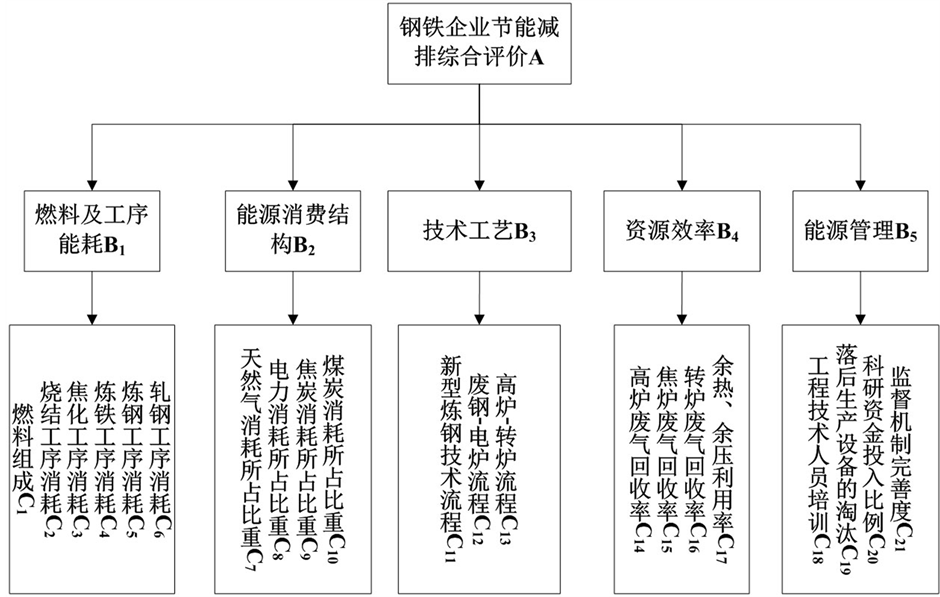1. 引言
钢铁行业作为我国经济发展的支柱型产业,是资源和能源密集型产业,同时也是典型的耗能和排放大户。高消耗、高排放、高污染的特征使钢铁行业成为国家节能减排重点关注目标。在2007年国家公布的《节能减排综合性工作方案》中,要求建立和完善节能减排指标体系、监测体系和考核体系;在2010年公布的《钢铁行业生存经营规范条件》及2012年的《钢铁行业规范条件(2012年修订)》中,对钢铁企业的环境保护、能源消耗和资源综合利用、生产规模等方面做了新的规定,提出了具体条件,如,吨钢二氧化硫排放量不超过1.63千克,固体废弃物综合利用率不低于94% [1] 。在日趋严格的能源和环境保护政策下,钢铁行业成为节能减排的重点对象。钢铁行业实现节能减排不仅对其实现可持续发展意义重大,而且也是应对全球气候环境问题、实现我国节能减排战略和转变经济发展方式的迫切需要。建立科学健全的钢铁企业节能减排绩效评价指标体系是钢铁行业建立和完善节能减排评价体系的重要组成部分,对于实现钢铁行业低碳、可持续发展具有重要意义。
2. 研究现状
目前,国内外学者在钢铁企业的节能减排研究上还不太深入,多集中在对钢铁企业节能减排现状与减排潜力分析、减排政策分析及节能减排影响因素等方面的研究[2] -[6] ,对其节能减排绩效评价方面的研究较少,且仅从宏观上考虑经济、技术、环境、企业规模等变量的影响[7] [8] ,对于企业内部节能减排的评价多局限于对单位总的能耗和主要污染物排放总量等指标的考核上或对某一方面减排效果的评价[9] [10] ,评价指标较为单一、考核较为片面。在企业节能减排评价方面,多采用一些传统方法对船舶企业、港航系统以及港口等企业节能减排进行分析,主要有层次分析法、因子分析法、模糊评价法等[11] -[13] 。影响钢铁企业节能减排的因素多且复杂,而单一方法不能全面考量各项影响因素,因此存在一定的不完整性。本文从系统理论出发,结合影响钢铁企业节能减排的各方面因素,在层次分析法(AHP)的基础上建立较为全面的评价指标体系,并结合模糊评价模型对钢铁企业节能减排工作进行综合评价,以求比较客观正确地反映钢铁企业节能减排工作的状况,为实现钢铁行业的低碳可持续发展提供参考依据。
3. 评价指标体系和评语集
AHP-模糊综合评价法不仅能有效降低确定各指标权重时人为因素带来的误差,同时又能比较直观地反映钢铁行业节能减排工作的最终表现,对改善钢铁企业节能减排相关政策措施的制定有非常重要的指导意义。
3.1. 评价指标体系
评价指标体系是一个多层次、非线性、动态模糊的复杂系统,要科学合理地评价钢铁企业节能减排的工作情况,首先必须确定能够反映其综合状况的因素,从而建立起科学合理的评价指标体系[14] [15] ,因此,选取恰当、合理的指标体系是建立钢铁企业节能减排考核评价指标体系的重要环节。影响钢铁企业节能减排效率的因素是多方面,本文主要从原料及工序能耗、能源消费结构、技术工艺、资源效率和能源管理五个层面分析了钢铁企业节能减排的主要影响因素。
3.1.1. 原料及工序能耗
钢铁生产需要消耗大量的原料,其能耗70%左右在炼铁及铁前工序,同时生产工艺过程也会排放大量的环境污染物。因此工序能耗是钢铁企业节能减排的一大影响因素。钢铁工业的工序主要有焦化、烧结、炼铁、转炉、电炉及轧钢,其中最大的工序能耗为炼铁工序,其次依次为电炉、焦化、轧钢等。
3.1.2. 能源消费结构
钢铁企业在生产过程中所消耗的能源消费种类繁多,主要以煤炭、石油、天然气和电力为主,但煤炭在我国一次能源消费中所占比重仍然很大。钢铁企业消耗的能源主要还以煤炭和电力为主,其他能源相对来说占据比重较小。但煤炭的利用率要低于其他能源的利用率,且煤炭在运输和终端消费过程中也会产生很多能源消耗,因此,能源结构变动会对钢铁企业节能减排产生直接影响。
3.1.3. 技术工艺
现代钢铁企业的主要生产工艺流程为长流程和短流程。目前全球大约70%的钢铁企业采用高炉—转炉长流程生产工艺,电炉炼钢工艺约占20%。从再生、循环利用和有效利用的潜在能源观点来看,电炉所代表的废钢返回料冶炼法是有效的,因此,电炉炼钢是一种资源回收在利用过程,也是一种处理污染的环保技术。
3.1.4. 资源效率
资源效率指标也是钢铁企业节能减排的影响因素,资源效率的改善,使钢铁企业减排具有较大的潜力。在钢铁生产过程中会产生大量的复产煤气和余热余能,但大量低品质余热资源尚未得到有效利用,焦炉煤气、高炉煤气放散率仍较高,转炉煤气回收量也较低,因此,充分、合理利用副产煤气,提高资源利用效率是钢铁企业节能降耗的关键所在。
3.1.5. 能源管理
随着国家能源供需矛盾的进一步扩大、环保政策的进一步强化以及钢铁企业自身发展的需要,加强能源管理对于钢铁企业的节能降耗和可持续发展产生的积极作用越来越显著。能源管理可以说是钢铁企业节能减排的源头所在,有越来越多的钢铁企业已经开始从传统的装备节能向同时重视能源系统节能转变,因此,能源管理也是影响钢铁企业节能减排的重要因素。
在上述分析的基础上,根据国家及钢铁行业节能减排工作相关的法规、规范和文件,参照大量文献资料中关于钢铁工业节能减排及可持续发展方面的内容,并调研了一些专家观点和大量的数据,确定了钢铁企业节能减排考核评价指标体系,如图1所示。该评价指标体系共有2层因素集。第1层为主因素,

Figure 1. The evaluation index system of energy conservation and emission reduction of iron and steel industry
图1. 钢铁企业节能减排绩效评价指标体系
评价指标共有5个。主因素下面还有若干个影响指标,共21个。
3.2. 评价因素集和评语集
影响钢铁企业节能减排绩效的因素较多,而且由于人为主观性导致这些影响因素都具有模糊性,因此,对于各影响指标,采用模糊统计法中隶属度赋值法进行量化,以增加指标体系的准确性。首先,确定评语集 ,并请专家对影响钢铁企业节能减排绩效的各个因素指标进行评分;其次,建立绩效水平评语集
,并请专家对影响钢铁企业节能减排绩效的各个因素指标进行评分;其次,建立绩效水平评语集 ,对应为(好,较好,一般,较差,差),并赋予评语集各元素对应的向量值
,对应为(好,较好,一般,较差,差),并赋予评语集各元素对应的向量值 ,100表示节能减排绩效水平高,60表示节能减排绩效水平低。
,100表示节能减排绩效水平高,60表示节能减排绩效水平低。
4. 综合评价模型
4.1. 评价指标权重的确定
由于评价指标体系对钢铁企业节能减排工作的最终影响程度各不相同,因此邀请10位钢铁行业节能减排方面的工作人员及专家按照“1~9比例标度法”通过对各模糊因素两两比较构造判断矩阵,并计算权重。
4.1.1. 构建判断矩阵
在某一层次的元素在上一层次的某个准则约束下,指标间两两相对重要程度进行比较,使任意两项因素的相对重要性根据判断得到定量的描述,其分值相对应的重要性采用“1~9比例标度法”来确定。将全部比较结果用矩阵
 表示,其中,
表示,其中, 就是指标层第i个指标相对于第j个指标对上一层的重要性。
就是指标层第i个指标相对于第j个指标对上一层的重要性。
4.1.2. 确定评价指标权重
权重的计算实际上可以归结为求解判断矩阵的特征根 和特征向量
和特征向量 ,特征向量即为对应元素的权重值,特征根用于检验判断矩阵的一致性水平。本文采用方根法计算指标权重,其步骤如下:
,特征向量即为对应元素的权重值,特征根用于检验判断矩阵的一致性水平。本文采用方根法计算指标权重,其步骤如下:
根据 ,
, 。计算判断矩阵每一行元素的乘积;计算
。计算判断矩阵每一行元素的乘积;计算 的
的 次方根
次方根 ;对向量
;对向量 做归一化或正规化处理,即
做归一化或正规化处理,即 ,则
,则 即为所求的特征向量;计算判断矩阵的最大特征向量,即
即为所求的特征向量;计算判断矩阵的最大特征向量,即 ,
, 表示判断矩阵
表示判断矩阵 与权重向量
与权重向量 相乘后得到的新向量,
相乘后得到的新向量, 为
为 的第
的第 个元素;计算一致性指标
个元素;计算一致性指标 和随机一致性指标
和随机一致性指标 ,
,
平均随机一致性指标RI根据萨蒂给出的RI值(表1)查找得出。一般用CR检验判断矩阵的一致性,CR愈小,判断矩阵的一致性愈好,通常认为CR < 0.1时,判断矩阵满足一致性检验;否则,应对判断矩阵修正后重新计算,直至检验通过。
4.2. 评价指标隶属度的确定
由于评价指标体系中各指标都具有一定的模糊性,因此通过每一指标隶属于各等级评语的隶属度来减弱这种模糊性。
4.2.1. 定量指标隶属度的确定
定量指标等级的评价设置为“好,较好,一般,较差,差”五个等级,本文选取的定量指标有15个,具体评价标准见表2。
4.2.2. 定性指标隶属度的确定
本文除了上述15个定量指标外,其余6个指标为定性指标。定性指标也分为“好,较好,一般,较差,差”五个等级。定性指标评价矩阵根据专家组投票统计确定。通过专家调查问卷和电话访谈等形式,咨询相关专家10人对于6个定性指标进行投票,统计评价结果见表3。
4.3. 综合评价
求出上述21个指标的隶属度,并对其进行归一化处理后,得到模糊矩阵 :
:

并得到AHP-模糊综合评价模型 :
:


Table 1. The random consistency index RI
表1. 随机一致性指标RI

Table 2. The quantitative index evaluation grade
表2. 定量指标评价等级

Table 3. The qualitative index evaluation grade
表3. 定性指标评价等级
由最大隶属度原则得出钢铁企业节能减排工作的评价等级,并利用加权平均原则得出钢铁企业节能减排工作的最终得分情况。
4.4. 实证分析
以安徽省马鞍山市某钢铁企业为例,对于本文评价指标体系涉及到的定量指标进行实地调查,并向市环保局、企业工作人员以及高校钢铁领域专家学者发放调查问卷的方法获取定性指标相关数据,对其节能减排绩效进行考核评价。
整理10份专家学者最终的打分得到各指标判断矩阵,以准则层指标判断矩阵为例,结果见表4。
根据前述指标权重计算步骤,首先计算判断矩阵每一行元素的乘积并对其进行标准化处理得特征向量 ;将结果代入最大特征向量公式,得
;将结果代入最大特征向量公式,得 ;使用一致性检验公式得
;使用一致性检验公式得 ,查找相应的平均随机一致性指标
,查找相应的平均随机一致性指标 ,得
,得 。因此,
。因此, ,认为该判断矩阵的一致性是可以接受的。对求得的特征向量求解算术平均值,得出准则层的权重值为
,认为该判断矩阵的一致性是可以接受的。对求得的特征向量求解算术平均值,得出准则层的权重值为 。
。
同理,最终可得目标层各指标的权重向量A:
A =  = (0.0445,0.0447,0.0468,0.0416,0.0411,0.0413,0.0718,0.0718,0.1705,0.1209, 0.0549,0.0176,0.0176,0.012,0.0119,0.0269,0.0042,0.0430,0.0354,0.0527,0.0290)。结合实地调研所得定量指标数据及专家按照定性指标评价标准投票所得统计结果得出最终的模糊综合评价矩阵表,结果见表5。
= (0.0445,0.0447,0.0468,0.0416,0.0411,0.0413,0.0718,0.0718,0.1705,0.1209, 0.0549,0.0176,0.0176,0.012,0.0119,0.0269,0.0042,0.0430,0.0354,0.0527,0.0290)。结合实地调研所得定量指标数据及专家按照定性指标评价标准投票所得统计结果得出最终的模糊综合评价矩阵表,结果见表5。

根据模糊综合评价向量 可知,有12.52% 的专家认为该钢铁企业节能减排状况为“好”,48.3%的专家认为“较好”,36.43%的专家认为“一般”,2.75%的专家认为“较差”。依据最大隶属度原则可得该企业节能减排的综合评价结果为“较好”。
可知,有12.52% 的专家认为该钢铁企业节能减排状况为“好”,48.3%的专家认为“较好”,36.43%的专家认为“一般”,2.75%的专家认为“较差”。依据最大隶属度原则可得该企业节能减排的综合评价结果为“较好”。
为了使评价结果更加明确,本文拟求出该钢铁企业节能减排工作的实际分值。
设分数集 ,即分值在90~100的评价结果为“好”,80~90的为“较好”,70~80的为“一般”,60-70的为“较差”,60分以下为“差”。于是可得该钢铁企业节能减排工作的最后得分为:
,即分值在90~100的评价结果为“好”,80~90的为“较好”,70~80的为“一般”,60-70的为“较差”,60分以下为“差”。于是可得该钢铁企业节能减排工作的最后得分为:
 。由此结果可看出,该企业节能减排绩效水平介于较好(90)和一般(80)之间,更接近于较好水平。
。由此结果可看出,该企业节能减排绩效水平介于较好(90)和一般(80)之间,更接近于较好水平。
从上述评价过程可以看出,在准则层指标体系中原料及工序能耗与能源结构在钢铁企业节能减排工作评价中占据较重要的地位;在决策层指标中煤炭消耗与焦炭消耗在钢铁企业节能减排工作评价中占有较重要的位置。这表明资源和能源对钢铁工业的制约矛盾日趋突出,钢铁企业节能减排首先应该调整燃料结构,适当提高天然气等清洁能源的比例。另外,针对我国钢铁生产发展的特点,加快采用高新技术的改造和不断优化生产工序,提高能源利用效率和加大二次能源的回收利用,将是我国钢铁工业节能减排的主要途径。

Table 4. The criterion layer judgment matrix
表4. 准则层判断矩阵

Table 5. The fuzzy matrix of evaluation index
表5. 评价指标模糊矩阵
5. 结论与讨论
1) 本文依据目前钢铁行业节能减排工作的现状制定了对钢铁企业节能减排工作进行评估的评价指标体系,确定了各评价指标的权重,构造了隶属函数并确定了隶属度,减少了评价的主观性,使评价结果更加客观真实。
2) 在调研的基础上,以某钢铁企业为例运用AHP-模糊综合评价模型对其节能减排工作进行评价。评价结果表明该企业节能减排工作绩效为“较好”,评价结果与实际情况相符,这主要得益于企业对于节能减排工作和管理的重视,采用现代的管理手段,加大科研投入,大力开发碳减排的新产品和新技术,达到了节能降耗环保的目标,同时也取得较好的经济效益。
3) 本文所构建的节能减排评价体系通过实例运用,验证了AHP-模糊综合评价法对于钢铁企业节能减排评价的可行性,同时也为钢铁行业制定节能减排战略重点指明了方向,具有非常重要的指导意义。
基金项目
国家自然科学基金项目(编号:41301644)。